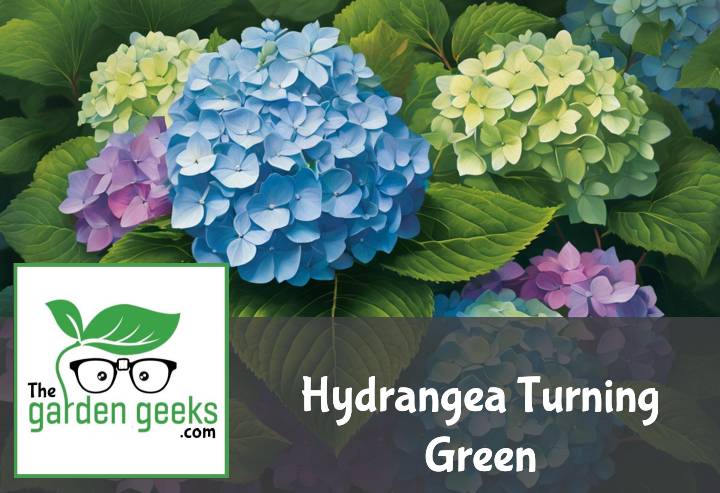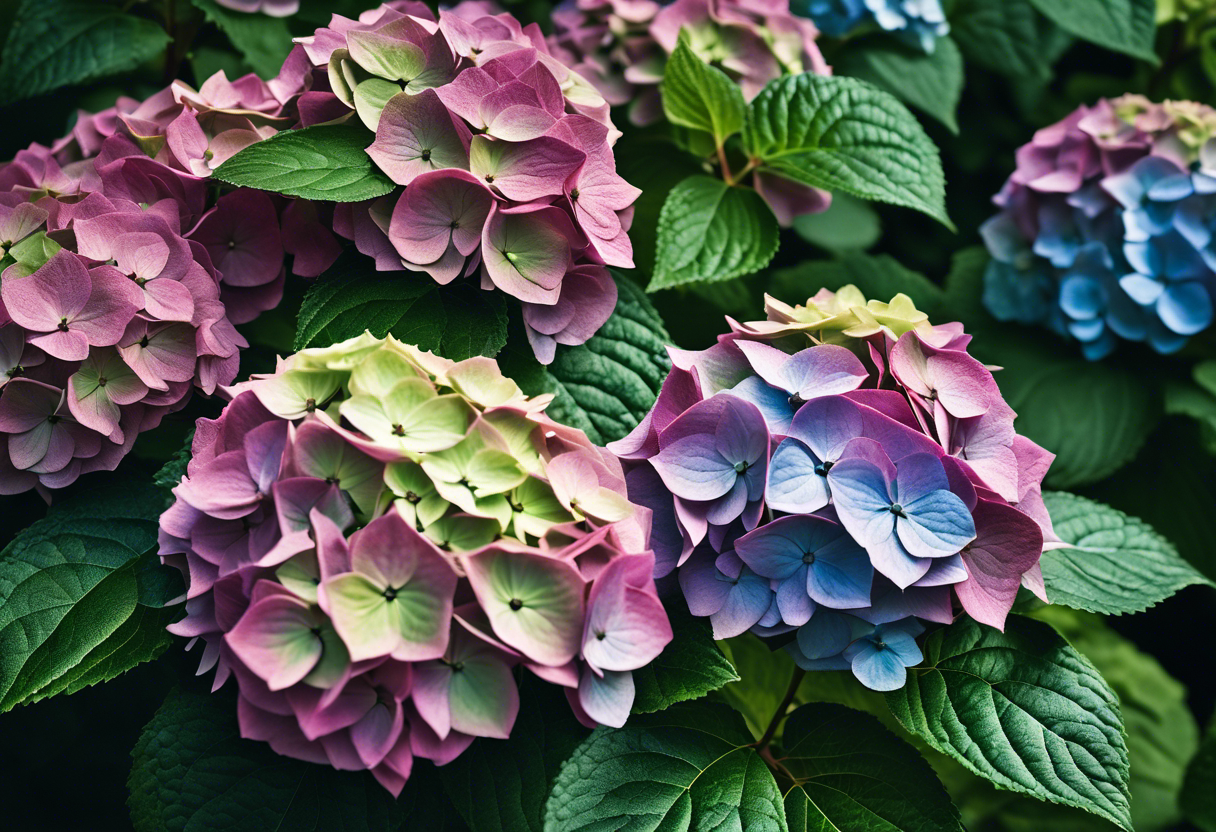Ever looked at your garden and thought, “Why on earth is my Hydrangea Turning Green?” Well, you’re not alone. I’ve been there, scratching my head, wondering if I’d accidentally turned into a green-thumbed Hulk overnight.
Don’t fret though! There’s usually a perfectly natural reason behind this color change. So grab your gardening gloves, we’re about to delve into the world of hydrangeas. Keep reading about ‘Hydrangea Turning Green? (3 Reasons)’ to unravel this green mystery!
Key Takeaways
- Hydrangeas turn green due to three main reasons: natural color change, insufficient sunlight, and improper pH levels in the soil.
- Some hydrangea varieties naturally change color from blue or pink to green as they age.
- Lack of sufficient sunlight can cause hydrangeas to turn green. They need at least 4 hours of direct sunlight daily.
- The pH level of the soil also affects the color. Acidic soil (pH below 6) turns hydrangeas blue, while alkaline soil (pH above 7) turns them pink. Green is often a transition stage.
Why Are My Hydrangeas Turning Green?
Ever wondered, “Why are my hydrangeas turning green?” Well, you’re not alone. It’s a common question among garden enthusiasts. The reasons can be as simple as natural color change, soil pH, or even seasonal changes.
Understanding the Natural Color Change
Now let’s get this straight – hydrangea color change is a normal part of their lifecycle. As hydrangeas age, they often shift from vibrant blues and pinks to a more subdued green hue. This green hue in flowers isn’t a sign of trouble but rather an indication of the aging process of hydrangeas.
The lifecycle of a hydrangea bloom is fascinating. They start off bright and bold, then mellow out into softer shades before finally settling on green. So if your hydrangea is turning green, it might just be growing up!
The Role of Soil pH in Color Change
Soil pH plays a big role in the color game too! The acidity or alkalinity level can influence your hydrangea colors. For instance, acidic soils tend to produce blue flowers while alkaline soils lean towards pink hues.
But what about green? Well, sometimes when the soil pH is imbalanced or fluctuating rapidly, it can cause your hydrangeas to turn green. It’s like nature’s own little chemistry experiment happening right in your backyard!
Impact of Seasonal Changes on Hydrangea Color
Seasons also have their say in the color saga! Different weather conditions throughout the year can affect the color of your blooms. Cold winters and hot summers both play their parts in this floral drama.
For example, harsh winter conditions may dull down the vibrant colors and lead to greener hues come springtime. On the other hand, intense summer heat could bleach out those bright tones resulting in more green hydrangeas. So, the weatherman might just be your new best friend when it comes to understanding your hydrangea’s color shift!
Reason 1: Ageing Process of Blooms
The hydrangea bloom aging process is a fascinating journey, with color changes being a natural part of this lifecycle. This includes the intriguing phenomenon of your hydrangea turning green, an age-related color shift we’ll delve into below.
How Age Affects Hydrangea Bloom Color
Ever noticed your hydrangeas taking on a greenish hue as they mature? Well, that’s the age influence on hydrangea color at play. As blooms age, their vibrant blues, pinks or purples can mellow out, leading to older hydrangeas turning green.
This isn’t a sign of ill health but rather a natural part of the aging process of hydrangeas. Just like us humans getting grey hairs over time, these plants also show their age through color changes!
Signs of Aging in Hydrangea Blooms
Now you might be wondering how to spot these aging signs in your beloved hydrangeas. Well, apart from the obvious color changes in hydrangeas, there are other visual cues to look out for.
Firstly, aged blooms tend to droop slightly under their own weight – think of it as plant posture! Secondly, the texture of the petals can change too; they often become papery and less supple as they age.
So next time you see your hydrangea turning green, don’t panic! It’s just showing off its maturity and continuing its natural lifecycle.
Reason 2: Environmental Factors
Your hydrangea turning green could be due to environmental factors. Sunlight, temperature, and weather conditions can all influence the color of your hydrangeas. Let’s dive into how these elements can cause a hydrangea color change.
Effect of Sunlight Exposure on Hydrangea Color
Sunlight plays a crucial role in determining the color of your hydrangeas. The more sunlight your plant gets, the more likely it is to turn green. This is due to photosynthesis, where plants convert light into energy.
You see, when hydrangeas are exposed to intense light, they produce more chlorophyll. And guess what? Chlorophyll is green! So, if you’ve got your green hydrangeas in sun, that might just be why they’re showing off that emerald hue.
But don’t go moving your plant into the shade just yet! Hydrangeas need some sunlight to thrive. It’s all about balance – too much direct sunlight can lead to direct sunlight impact on hydrangeas, causing them to turn green or even burn.
Influence of Temperature and Weather Conditions
Now let’s talk about temperature and weather conditions. These factors can also lead to your hydrangea turning green. Cold stress in plants can cause them to change color as a protective measure.
When temperatures drop suddenly, hydrangeas may respond by turning a darker shade of green. This is because cold temperatures slow down the process that breaks down chlorophyll (the stuff that makes plants green).
On the flip side, heat stress in hydrangeas can also cause a color shift towards green. When it gets too hot, plants will produce more chlorophyll as a way to protect themselves from sun damage.
So whether it’s cold snaps or heatwaves, seasonal changes affecting plant colors are something every gardener should be aware of. It’s all part of the fun of growing your own hydrangeas!
Reason 3: Nutrient Deficiency
Well, folks, the third reason your hydrangea turning green could be a simple case of nutrient deficiency. Yep, you heard it right! Just like us humans, plants too need their daily dose of nutrients to stay healthy. And when they don’t get enough, they start showing signs – like our dear hydrangeas turning an unexpected shade of green.
Importance of Proper Fertilization for Hydrangeas
Now let’s talk about proper fertilization. You see, hydrangea fertilization is not just about making your soil rich and fancy. It’s more like feeding your plant baby its favorite food. When hydrangeas get the right nutrients from the soil, they can maintain their stunning colors instead of turning into green hydrangeas.
But here’s the kicker – not all fertilizers are created equal. Some are better suited for hydrangeas than others. So make sure you’re using a fertilizer that’s specifically designed for these beauties to prevent them from going green on you.
Identifying Nutrient Deficiencies in Hydrangeas
So how do you know if your hydrangea is nutrient-deficient? Well, apart from the obvious sign of them turning green, there are other tell-tale signs too. Maybe the leaves are wilting or the blooms aren’t as vibrant as they used to be.
Once you’ve identified a possible nutrient deficiency, it’s time to take action! Start by testing your soil to see what nutrients it might be lacking. Then choose a fertilizer that can help restore those missing elements and bring back your hydrangea’s health and color.
Remember folks, diagnosing and treating green hydrangeas isn’t rocket science – but it does require some attention and care!
How to Maintain the Desired Color of Your Hydrangeas?
So, you’ve noticed your Hydrangea Turning Green and you’re wondering how to get back those vibrant hues. Well, it’s all about hydrangea color maintenance. The secret lies in the soil pH and proper care.
Adjusting Soil pH for Desired Bloom Colors
Did you know that soil pH and bloom colors are closely linked? It’s true! The acidity or alkalinity of your garden soil can directly influence your hydrangea bloom colors.
Now, here’s the fun part – by adjusting the soil pH, you can actually control these colors. Want blue blooms? You’ll need acidic soil. Pink more your style? Then aim for alkaline conditions.
But how do you go about adjusting soil pH? Easy peasy! For increasing acidity, try adding sulfur or peat moss to your soil. To make it more alkaline, garden lime is your best friend.
Proper Care and Maintenance Tips for Vibrant Blooms
Aside from playing with pH levels, there are other ways to keep your hydrangeas happy and colorful. Let’s talk about some essential hydrangea care tips.
First off, watering is key. Hydrangeas love water (it’s in their name after all), but too much can lead to root rot. So, keep the soil moist but not soggy.
Next up is pruning. Done right, it encourages new growth and more vibrant blooms. Just remember not to prune too much or too often – hydrangeas aren’t big fans of haircuts!
And let’s not forget fertilizing! A balanced fertilizer can work wonders for maintaining those vibrant blooms we all love so much.
In conclusion, if you’re dealing with a case of Hydrangea Turning Green, don’t panic! With a little bit of soil science and some TLC, you can get those stunning colors back in no time.
To Wrap Up
So, if your hydrangea is turning green, it’s not throwing a garden-variety tantrum. It’s just nature’s way of saying it needs a little TLC or maybe just doing its seasonal thing. Check out this Hydrangea Turning Green guide for more tips.
Remember, gardening is like baking; sometimes you have to tweak the recipe to get the perfect result. Happy hydrangea handling!





